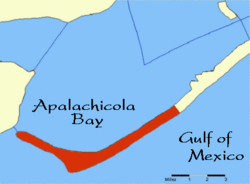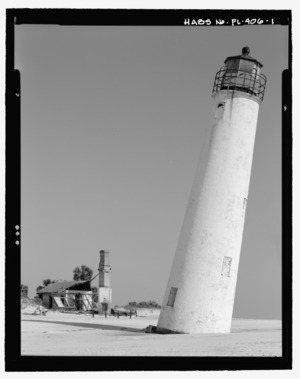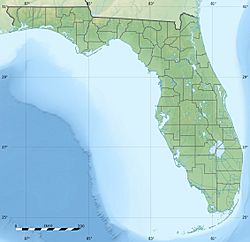Cape St. George Island facts for kids

Cape St. George Island, Florida.
|
|
| Geography | |
|---|---|
| Coordinates | 29°35′37″N 85°02′32″W / 29.5935°N 85.0421°W |
| Administration | |
| State | Florida |
| County | Franklin |
Cape St. George Island is also known as Little St. George Island. It is an island without people living on it, located off Florida's North Gulf Coast. This island is south of St. Vincent Island and west of St. George Island. It is about 8 to 10 miles southwest of Apalachicola in Franklin County, Florida.
Cape St. George Island used to be part of St. George Island. But in 1954, the U.S. Army Corps of Engineers built a ship channel called Bob Sikes Cut. This channel separated Cape St. George Island from the main island.
Contents
What is the History of Cape St. George Island?
For hundreds of years before Europeans arrived, different Native American groups lived on St. George Island. Sometimes, pieces of pottery from A.D. 750 to 1450 are found on older parts of the island.
In the 1830s, Apalachicola became Florida's biggest port because of the busy cotton trade. Many ships came in and out of Apalachicola Bay. This made a lighthouse very important for guiding them safely. In 1831, the Florida government received money to build a new lighthouse.
Why Were Lighthouses Built on the Island?
The first lighthouse was built in 1833 at the west end of the island. It was near West Pass, which was the main way into the bay. Because of the shape of St. George Island, a second lighthouse was built at the very southern tip. This helped guide ships even better.
However, the second lighthouse only lasted three years. It was not built very well and strong storms damaged it. A new lighthouse was built in 1852. It stood more than 500 yards inland from the Gulf of Mexico. But by 1990, the beach had worn away so much that the lighthouse was in danger. On July 10, 2005, the lighthouse finally fell into the water.

A new lighthouse, which looks just like the old Cape St. George lighthouse, was finished on December 1, 2006. It stands on nearby St. George Island.
How Was the Island Used in the Past?
From 1910 to 1916, pine trees on Cape St. George Island were "catfaced." This means cuts were made in the trees to collect turpentine, a useful liquid from pine sap.
During World War II, the island was used as a practice area for shooting guns. B-24 bombers from nearby Apalachicola practiced here. From 1950 to 1956, pine trees were again harvested for turpentine. The old buildings from the turpentine camp are still at the Government Dock.
Protecting the Island's Nature
In 1977, Cape St. George Island was bought to protect it from being developed. This was part of the Environmentally Endangered Lands program. It also helped protect Apalachicola Bay.
Today, Cape St. George State Reserve (also called Little St. George Island) is owned by the Florida Department of Environmental Protection's Florida Coastal Office. It is managed by the Apalachicola National Estuarine Research Reserve (ANERR). Because the island is far away and wild, it's a great place to see Florida's original natural landscape.
What is the Geography of Cape St. George Island?
The island has large grassy areas called savannahs. It also has old sand dune ridges and new sand dunes. You can find salt marshes, which are wetlands with salty water. Ponds and marshes are in the low, wet areas between the old dune ridges. There is also a small coastal hammock (a group of trees) and a black willow swamp.
What Can You Do for Fun on Little St. George Island?
Little St. George Island offers many fun activities. You can go hiking, enjoy the beach, kayak, watch wildlife, camp in simple sites, and fish.
How to Get to the Island
The island can only be reached by boat. Many local companies offer boat trips to the island and rent equipment. The main ways to get to the island are from Sike's Cut and the Marshall and Government docks. You'll find information boards at West Pass, Marshall House, and Sike's Cut. These boards describe all the fun things you can do.
Camping and Hiking on the Island
There are seven "Leave No Trace" camping sites on the island. "Leave No Trace" means you should leave the area exactly as you found it. Two sites are at West Pass, two at the Government Dock, two at Sike's Cut, and one sheltered platform is at the old lighthouse spot. People paddling along the Florida Circumnavigational Saltwater Paddling Trail get first choice at these sites. Camping is free, and you don't need a reservation with ANERR, but it's a good idea to make one.
There are two simple hiking trails near the middle of the island. The Island Ridge Trail goes west from Short Road and leads to a nice viewpoint of the Bay. You can make a moderate 3-mile loop by taking this trail out and the Old Bay Road back. Another simple trail winds along a dune ridge. It takes visitors from the Government Dock camp to the Gulf Beach (about 1 mile). On the far east end, the Sike's Cut Trail is 0.9 miles long. It can connect with the Gulf Beach to make a 1.6-mile loop. You can hike on all roads and beaches on Little St. George Island.
Important Rules for Visitors
Motorized vehicles are not allowed on the island. Pets are welcome, but they must be on a leash at all times. This is very important because the island's beaches and dunes are critical nesting places for shorebirds and sea turtles.
What Plants Grow on Cape St. George Island?
Cape St. George Island has many different types of plants. You can find shrubs and sea oats on the newer sand dunes. Slash pine flatwoods grow in the low, wet areas and savannahs. You can also see scattered cabbage palmetto trees on parts of the island that are sometimes covered by ocean water, especially at the east and west ends.
What Animals Live on Cape St. George Island?
There are not many large mammals on the island because it is far from the mainland. Raccoons, coyotes, and squirrels are the most common. However, many different kinds of birds visit the island. They are especially common during their spring and fall migrations.
Birds and Sea Creatures
Important birds of prey include the peregrine falcon, bald eagle, and osprey. Threatened loggerhead sea turtles and endangered green sea turtles and leatherback sea turtles lay their eggs on the beach all summer. Oystercatchers and endangered snowy plovers also nest here.
Reptiles and Other Animals
Cottonmouth snakes and rattlesnakes are common in the ponds and marshes. There are even a few gopher tortoises living in the higher sand dunes of the island.
In 1997, the island was used to help increase the population of the endangered red wolf. This was part of a program to help red wolves recover.
Images for kids




